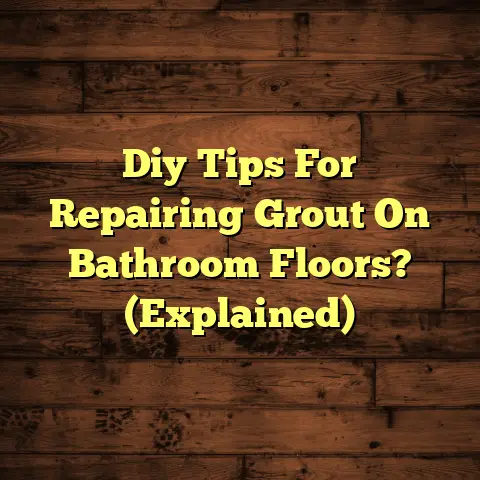How To Fix Squeaky Floorboards Australia? (Explained)
Did you know that approximately 30% of homeowners in Australia experience squeaky floorboards at some point?
This statistic might sound surprising, but I can assure you, it’s a common issue that many of us face.
Whenever I take on a flooring project, one of the recurring complaints from clients is about those annoying squeaks that can disrupt the peace in their homes.
Understanding Squeaky Floorboards
Squeaky floorboards may seem like a minor inconvenience, but they can lead to bigger problems if left unchecked.
Over time, the noises can become louder, and the underlying issues may worsen.
I remember my encounter with squeaky floorboards; I was working on a residential project in Sydney, and the homeowners were understandably frustrated with the constant squeaking.
This experience helped me realize how essential it is to address these noises promptly.
Do Floorboards Squeak?
There are several reasons why floorboards squeak. The main culprits include:
- Loose Floorboards: Over time, nails or screws can loosen, causing movement between the boards.
- Friction: When two surfaces rub against each other, it can produce noise.
This often happens when boards are not properly aligned or installed. - Humidity and Temperature Changes: Wood expands and contracts with changes in humidity and temperature, leading to gaps that can create squeaks.
Recognizing these factors is crucial because it helps in determining the right approach for fixing them.
Tools and Materials Needed
Before you start fixing those squeaky floorboards, make sure you have the right tools and materials on hand:
- Screwdriver or Drill
- Wood Screws or Nails
- Wood Glue
- Sound-Dampening Material (like felt pads)
- Measuring Tape
- Hammer
Having these tools ready will make the process smoother.
I always recommend my clients gather everything before starting to avoid interruptions.
Step-by-Step Guide to Fix Squeaky Floorboards
1. Identify the Source of the Squeak
Start by walking around the area and pinpointing where the squeaks are coming from.
It might require a bit of detective work.
I’ve found that the noise can travel through the structure, making it tricky to find the exact spot.
- Walk slowly across the floor, listening carefully.
- Try to distinguish between different sounds; some might come from loose boards, while others may indicate structural issues.
2. Secure Loose Floorboards
Once you’ve identified the squeaky area, it’s essential to secure any loose floorboards:
- Locate the Floor Joists: Use a stud finder to understand where to place your screws for maximum support.
- Using a Drill: Add wood screws into the loose floorboards and the joists beneath.
Be sure not to over-tighten, as this can cause damage to the wood.
I remember a job I did in Brisbane where the entire living room floor was creaking.
After identifying the joists, I added screws strategically, which resolved most of the noise immediately.
3. Apply Wood Glue
For areas where boards are rubbing against each other, applying wood glue can provide extra support:
- Spread a Thin Layer of Wood Glue: Apply it between the squeaky boards and press them together.
- Allow adequate time for the glue to dry before walking on it again.
One time, I had a client who was skeptical about using glue, thinking it wouldn’t last.
However, after explaining how modern wood glues work, they allowed me to proceed.
The results were impressive; they reported no more squeaks!
4. Use Sound-Dampening Material
For those persistent squeaks, you might consider using sound-dampening materials:
- Place Felt Pads: These can be placed between floorboards to reduce friction and absorb sound.
- This is especially useful in high-traffic areas where noise is more noticeable.
I’ve worked on several projects where homeowners opted for this solution after experiencing ongoing issues despite repairs.
It provided immediate relief without heavy-duty renovations.
5. Check for Gaps
Gaps between floorboards can also lead to noise:
- Use Wood Filler: Fill any gaps that have developed over time.
- Once filled, sand down the area for a smooth finish.
During one particular renovation in Adelaide, I noticed significant gaps between old floorboards that were causing severe creaking.
After filling those gaps with a quality wood filler and sanding them down, we achieved a remarkable difference in sound.
Challenges I’ve Faced
Throughout my years as a flooring contractor, I’ve encountered various challenges when addressing squeaky floorboards.
One memorable project involved an older home in Melbourne where the floor joists had settled unevenly over time.
No matter what I tried, the squeaks persisted due to structural issues beneath the surface.
In those cases, I’ve found it essential to communicate with homeowners about potential underlying problems and discuss solutions like reinforcing joists or even replacing sections of flooring if necessary.
The transparency here is key; clients appreciate knowing what they’re up against.
Cost Considerations
When it comes to fixing squeaky floorboards, costs can vary widely based on the extent of the repairs needed.
In general:
- Basic Repairs: Tightening screws or applying glue can cost around AUD 100–300.
- More Extensive Work: Reinforcing joists or replacing boards can range from AUD 500 to over AUD 1,500.
I often rely on FloorTally for accurate cost estimates on flooring projects.
It helps me pull local material prices and labor rates, ensuring I provide clients with realistic budgets right from the start.
This not only builds trust but also helps avoid surprises later on.
Different Approaches I’ve Tried
In my experience, there are several approaches to fixing squeaky floorboards:
- Adding Screws: This is often my first line of defense.
It’s straightforward and generally effective. - Using Wood Glue: When friction is the issue, glue can be a game-changer.
- Felt Pads: These are particularly helpful for noisy areas that see a lot of foot traffic.
- Reinforcing Joists: In older homes with significant settling issues, this approach has proven necessary.
Each method has its advantages and drawbacks, but often a combination yields the best results.
For instance, while adding screws may solve many problems initially, using wood glue alongside them can provide long-term stability.
Tips for Preventing Future Issues
After fixing squeaky floorboards, it’s wise to take steps to prevent future problems:
- Regular Maintenance: Routinely check for loose boards or signs of wear.
- Control Humidity: Use dehumidifiers in damp areas to prevent wood expansion and contraction.
- Choose Quality Flooring Materials: Higher-quality boards are less likely to develop issues over time.
I always remind my clients that taking care of their floors regularly will save them money and hassle in the long run.
Preventive measures are worth their weight in gold!
Addressing Advanced Issues
Sometimes, squeaks may indicate more serious problems that need attention beyond simple fixes.
Here are some advanced approaches I’ve taken:
Inspecting Subflooring
In some cases, I’ve discovered that subflooring is damaged or improperly installed:
- A thorough inspection revealed warped or rotting subfloor materials requiring replacement.
- This often involves lifting carpet or other flooring types to access this layer.
One time in a historic home in Tasmania, I had to replace sections of subflooring due to water damage.
Once completed, we laid new hardwood flooring that not only looked beautiful but also eliminated those pesky sounds.
Replacing Floor Joists
Another situation I’ve encountered was when existing floor joists were too thin or spaced too far apart:
- This often requires structural reinforcement through additional joists or plywood.
- It’s crucial to ensure that any new materials match existing ones for consistency.
During a project in Perth, I had a client whose older home had sagging floors because of inadequate joist support.
Reinforcing with additional joists not only fixed the squeak but also improved overall stability.
Personal Anecdotes and Insights
Throughout my career as a flooring contractor, I’ve seen firsthand how important it is to address squeaky floors quickly.
I recall one particular job where clients were preparing to sell their home but were embarrassed by loud noises whenever someone walked through the living room.
By tackling the problem head-on—securing loose boards and applying sound-dampening materials—we managed to eliminate nearly all noise before their open house.
The relief on their faces when they realized they could walk freely without creaks was priceless!
Conclusion
Dealing with squeaky floorboards may seem overwhelming at first, but with a little patience and the right approach, it can be a manageable task.
I’ve shared my experiences and methods that have worked for me over the years, but remember that every home is unique.
If you encounter persistent issues or if your floors are particularly old or complex, don’t hesitate to consult with professionals who can assess your specific situation.
Fixing squeaky boards not only enhances comfort but also improves the overall value of your home.





